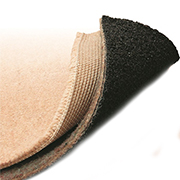
Axfelt Underlay
£POA
General Guidelines on Underlays for Residential use
Carpets are installed on a wide variety of underlays and whilst we know that in the majority of cases an acceptable performance of carpet and underlay may be achieved, careful choice of underlay can actually enhance the performance of the carpet. We acknowledge that there is a balance to be achieved between providing the right underfoot comfort and the right support to the carpet and from our experience and evaluation of various underlays we would make the following points.
Benefits of Firmer underlays:
These give added protection to the carpet against the hard sub-floor during normal walking.
Indentations from furniture will be less severe where the carpet is fitted on a firm underlay.
Firmer underlays will prevent excessive vertical movement and stretching of the carpet in use and will therefore help to prevent rucking problems.
Comments on Softer underlays:
Soft, low density underlays do not give adequate support in heavy wear areask, as the carpet pile is effectively squashed against the sub-floor, accelerating wear and appearance changes.
A softer product will collapse under the pressure and allow the carpet backing to be distorted, preventing good recovery and making indentations more severe.
Thicker, softer products have been seen to create dimensional stability problems in some installations, where the carpet has stretched, due to the excessive vertical movement, as the underlay is compressed during normal use.This can cause particular problems on seams.
In our experience it is false economy to fit new carpet over old or softer, cheaper underlay. As already mentioned, carpet needs to have as firm a support as possible, in order to achieve it's maximum performance. An old, flattened, or new, soft, underlay, will not be capable of providing adequate support to the carpet.
Preferred types of underlay:
Good quality hair felts minimum weight 42oz per square yard.
Firm crumb rubber underlays or high density supportive foam are also recommended. Generally, we prefer underlays which are not too thick, we suggest a maximum thickness of 8mm
Felt/rubber combinations in the form of a sandwich are also recommended, as these combine the support of the felt with a softer “bouncier” feel during walking
Thick, softer foam with holes or egg box or waffle type backings and lightweight felts are not recommended.
Choice of underlay for Stairs:
The choice of underlay on stairs is particularly important and, again, firmer products are needed to give a good cushion and support the carpet. Felt or felt combination products help to “round out” the stair nosing, preventing premature wear and will at the same time give a better more rounded appearance to each stair.
Equalising Wear on Stairs:
In most households, the carpet on the stairs receives the heaviest wear. The wear is usually concentrated towards the centre of the stairs and the carpet over the nosing takes the greatest punishment. For this reason, it is recommended that a stair carpet should receive special attention to equalise the wear over it's lifetime. The retailer/fitter will be able to advise on the best approach to this in any particular installation. The most common approach on a straight staircase is to allow an extra length of carpet, equivalent to the riser and tread (about 0.46m or 18 inches), so that the carpet can be shifted periodically. Where shifting is not possible, consideration should be given to the purchase of sufficient material to replace of areas of high wear, e.g. turning points at top and bottom of stairs or on half landings.